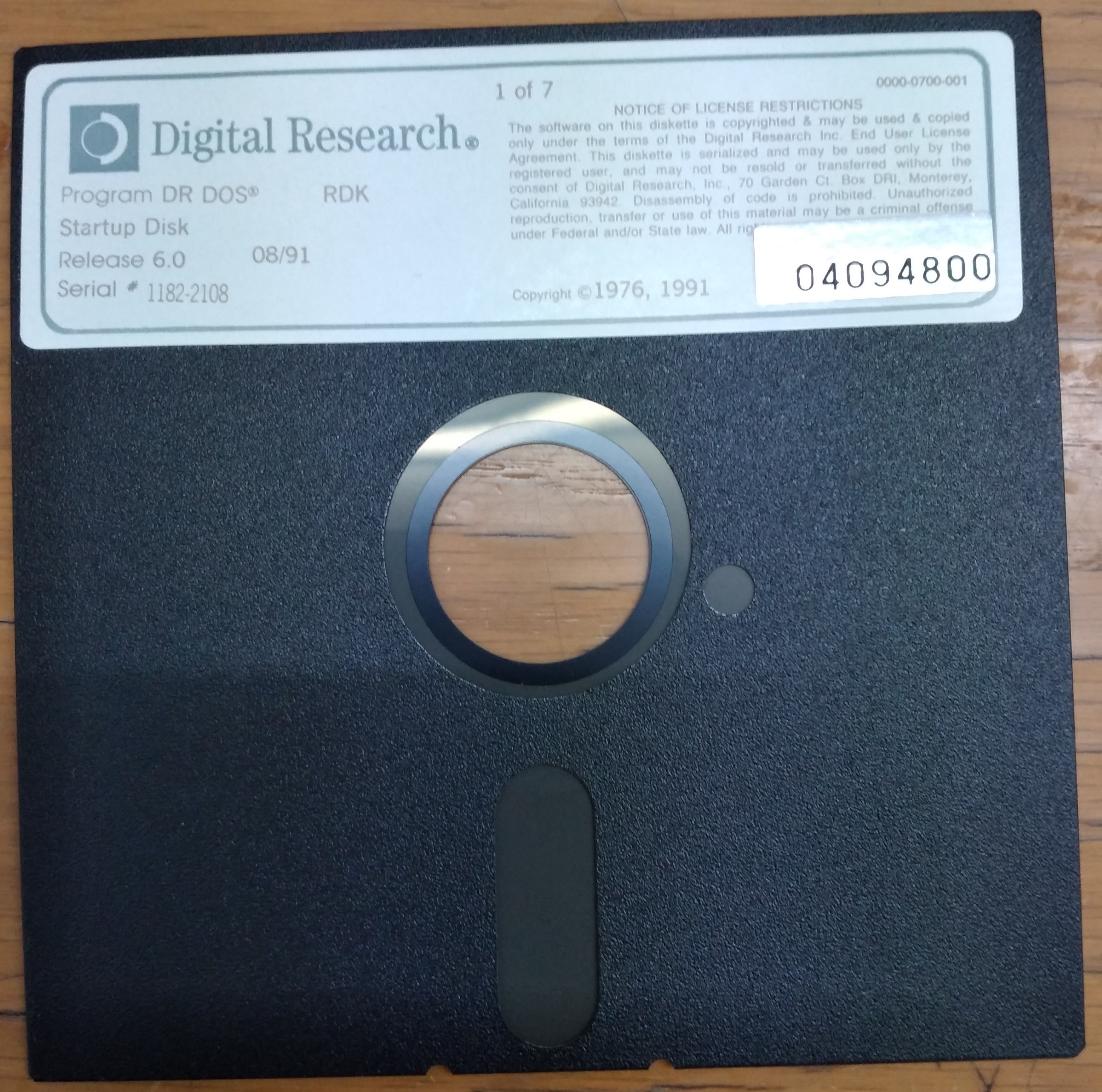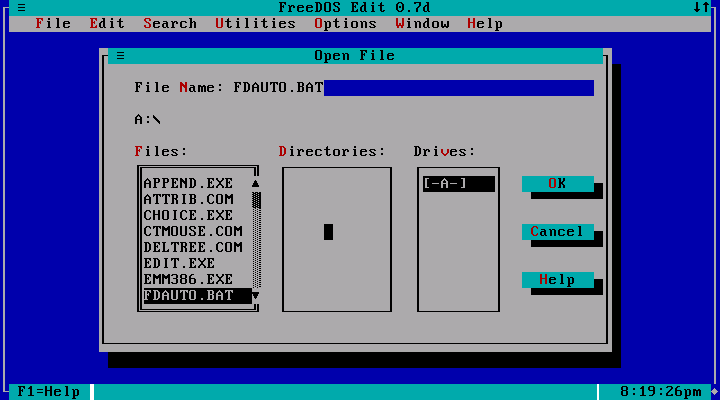|
Command.com
COMMAND.COM is the default command-line interpreter for MS-DOS, Windows 95, Windows 98 and Windows Me. In the case of DOS, it is the default user interface as well. It has an additional role as the usual first program run after boot (init process), hence being responsible for setting up the system by running the AUTOEXEC.BAT configuration file, and being the ancestor of all processes. COMMAND.COM's successor on OS/2 and Windows NT systems is cmd.exe, although COMMAND.COM is available in virtual DOS machines on IA-32 versions of those operating systems as well. The filename was also used by (DCP), an MS-DOS derivative by the former East German VEB Robotron. The compatible command processor under FreeDOS is sometimes also named FreeCom. COMMAND.COM is a DOS program. Programs launched from COMMAND.COM are DOS programs that use the DOS API to communicate with the disk operating system. Operating modes As a shell, COMMAND.COM has two distinct modes of operation. The first i ... [...More Info...] [...Related Items...] OR: [Wikipedia] [Google] [Baidu] |
Command-line Interpreter
A command-line interpreter or command-line processor uses a command-line interface (CLI) to receive command (computing), commands from a user in the form of lines of text. This provides a means of setting parameters for the environment, invoking executables and providing information to them as to what actions they are to perform. In some cases the invocation is conditional based on conditions established by the user or previous executables. Such access was first provided by computer terminals starting in the mid-1960s. This provided an interactive environment not available with punched cards or other input methods. Today, many users rely upon graphical user interfaces and menu-driven interactions. However, some programming and maintenance tasks may not have a graphical user interface and use a command line. Alternatives to the command-line interface include text-based user interface menu (computing), menus (for example, IBM AIX SMIT), keyboard shortcuts, and various desktop met ... [...More Info...] [...Related Items...] OR: [Wikipedia] [Google] [Baidu] |
MSX-DOS
MSX-DOS is a discontinued disk operating system developed by Microsoft for the 8-bit home computer standard MSX, and is a cross between MS-DOS 1.25 and CP/M-80 2. MSX-DOS MSX-DOS and the extended BASIC with 3½-inch floppy disk support were simultaneously developed by Microsoft and Spectravideo as a software and hardware standard for the MSX home computer standard, to add disk capabilities to BASIC and to give the system a cheaper software medium than Memory Cartridges, and a more powerful storage system than cassette tape. The standard BIOS of an unexpanded MSX computer did not have any floppy disk support, so the additional floppy disk expansion system came with its own BIOS extension ROM (built-in on the disk controller) called the BDOS. Spectravideo also released an MSX-DOS disk in conjunction with the SVI-707 which could be loaded into an MSX system. Once MSX-DOS has been loaded, the system searches the MSX-DOS disk for the COMMAND.COM file and loads it into memory ... [...More Info...] [...Related Items...] OR: [Wikipedia] [Google] [Baidu] |
MS-DOS
MS-DOS ( ; acronym for Microsoft Disk Operating System, also known as Microsoft DOS) is an operating system for x86-based personal computers mostly developed by Microsoft. Collectively, MS-DOS, its rebranding as IBM PC DOS, and a few operating systems attempting to be compatible with MS-DOS, are sometimes referred to as "DOS" (which is also the generic acronym for disk operating system). MS-DOS was the main operating system for IBM PC compatibles during the 1980s, from which point it was gradually superseded by operating systems offering a graphical user interface (GUI), in various generations of the graphical Microsoft Windows operating system. IBM licensed and re-released it in 1981 as PC DOS 1.0 for use in its PCs. Although MS-DOS and PC DOS were initially developed in parallel by Microsoft and IBM, the two products diverged after twelve years, in 1993, with recognizable differences in compatibility, syntax, and capabilities. Beginning in 1988 with DR-DOS, Co ... [...More Info...] [...Related Items...] OR: [Wikipedia] [Google] [Baidu] |
Caldera UK
DR-DOS (written as DR DOS, without a hyphen, in versions up to and including 6.0) is a disk operating system for IBM PC compatibles. Upon its introduction in 1988, it was the first DOS attempting to be compatible with IBM PC DOS and MS-DOS (which were the same product sold under different names). DR-DOS was developed by Gary A. Kildall's Digital Research and derived from Concurrent PC DOS 6.0, which was an advanced successor of CP/M-86. As ownership changed, various later versions were produced with names including Novell DOS and Caldera OpenDOS. History Origins in CP/M Digital Research's original CP/M for the 8-bit Intel 8080- and Z-80-based systems spawned numerous spin-off versions, most notably CP/M-86 for the Intel 8086/ 8088 family of processors. Although CP/M had dominated the market since the mid-1970s, and was shipped with the vast majority of non-proprietary-architecture personal computers, the IBM PC in 1981 brought the beginning of what was eventually ... [...More Info...] [...Related Items...] OR: [Wikipedia] [Google] [Baidu] |
DR-DOS
DR-DOS (written as DR DOS, without a hyphen, in versions up to and including 6.0) is a disk operating system for IBM PC compatibles. Upon its introduction in 1988, it was the first DOS attempting to be compatible with IBM PC DOS and MS-DOS (which were the same product sold under different names). DR-DOS was developed by Gary A. Kildall's Digital Research and derived from Concurrent PC DOS 6.0, which was an advanced successor of CP/M-86. As ownership changed, various later versions were produced with names including #Novell DOS, Novell DOS and #OpenDOS, Caldera OpenDOS. History Origins in CP/M Digital Research's original CP/M for the 8-bit Intel 8080- and Zilog Z80, Z-80-based systems spawned numerous spin-off versions, most notably CP/M-86 for the Intel 8086/Intel 8088, 8088 family of processors. Although CP/M had dominated the market since the mid-1970s, and was shipped with the vast majority of non-proprietary-architecture personal computers, the IBM PC in 1981 bro ... [...More Info...] [...Related Items...] OR: [Wikipedia] [Google] [Baidu] |
Virtual DOS Machine
Virtual DOS machines (VDM) refer to a technology that allows running 16-bit/32-bit DOS and 16-bit Windows programs when there is already another operating system running and controlling the hardware. Overview Virtual DOS machines can operate either exclusively through typical software emulation methods (e.g. dynamic recompilation) or can rely on the virtual 8086 mode of the Intel 80386 processor, which allows real mode 8086 software to run in a controlled environment by catching all operations which involve accessing protected hardware and forwarding them to the normal operating system (as exceptions). The operating system can then perform an emulation and resume the execution of the DOS software. VDMs generally also implement support for running 16- and 32-bit protected mode software (DOS extenders), which has to conform to the DOS Protected Mode Interface (DPMI). When a DOS program running inside a VDM needs to access a peripheral, Windows will either allow this directl ... [...More Info...] [...Related Items...] OR: [Wikipedia] [Google] [Baidu] |
NTVDM
Virtual DOS machines (VDM) refer to a technology that allows running 16-bit/32-bit DOS and 16-bit Windows programs when there is already another operating system running and controlling the hardware. Overview Virtual DOS machines can operate either exclusively through typical software emulation methods (e.g. dynamic recompilation) or can rely on the virtual 8086 mode of the Intel 80386 processor, which allows real mode 8086 software to run in a controlled environment by catching all operations which involve accessing protected hardware and forwarding them to the normal operating system (as exceptions). The operating system can then perform an emulation and resume the execution of the DOS software. VDMs generally also implement support for running 16- and 32-bit protected mode software (DOS extenders), which has to conform to the DOS Protected Mode Interface (DPMI). When a DOS program running inside a VDM needs to access a peripheral, Windows will either allow this directly (r ... [...More Info...] [...Related Items...] OR: [Wikipedia] [Google] [Baidu] |
FreeCom
FreeDOS (formerly Free-DOS and PD-DOS) is a free software operating system for IBM PC compatible computers. It intends to provide a complete MS-DOS-compatible environment for running legacy software and supporting embedded systems. FreeDOS can be booted from a floppy disk or USB flash drive. It is designed to run well under virtualization or x86 emulation. Unlike most versions of MS-DOS, FreeDOS is composed of free software, licensed under the terms of the GNU General Public License. However, other packages that form part of the FreeDOS project include non-GPL software considered worthy of preservation, such as 4DOS, which is distributed under a modified MIT License. History The FreeDOS project began on 29 June 1994, after Microsoft announced it would no longer sell or support MS-DOS. Jim Hall – who at the time was a student – posted a manifesto proposing the development of PD-DOS, a public domain version of DOS. Within a few weeks, other programmers including P ... [...More Info...] [...Related Items...] OR: [Wikipedia] [Google] [Baidu] |
86-DOS
86-DOS (known internally as QDOS, for Quick and Dirty Operating System) is a discontinued operating system developed and marketed by Seattle Computer Products (SCP) for its Intel 8086-based computer kit. 86-DOS shared a few of its commands with other operating systems like OS/8 and CP/M, which made it easy to port programs from the latter. Its application programming interface was very similar to that of CP/M. The system was licensed and then purchased by Microsoft and developed further as MS-DOS and PC DOS. History Origins 86-DOS was created because sales of the Seattle Computer Products 8086 computer kit, demonstrated in June 1979 and shipped in November, were languishing due to the absence of an operating system. The only software that SCP could sell with the board was Microsoft's Standalone Disk BASIC-86, which Microsoft had developed on a prototype of SCP's hardware. SCP wanted to offer the 8086-version of CP/M that Digital Research had initially announced fo ... [...More Info...] [...Related Items...] OR: [Wikipedia] [Google] [Baidu] |
FreeDOS
FreeDOS (formerly Free-DOS and PD-DOS) is a free software operating system for IBM PC compatible computers. It intends to provide a complete MS-DOS-compatible environment for running legacy software and supporting embedded systems. FreeDOS can be booted from a floppy disk or USB flash drive. It is designed to run well under virtualization or x86 emulation. Unlike most versions of MS-DOS, FreeDOS is composed of free software, licensed under the terms of the GNU General Public License. However, other packages that form part of the FreeDOS project include non-GPL software considered worthy of preservation, such as 4DOS, which is distributed under a modified MIT License. History The FreeDOS project began on 29 June 1994, after Microsoft announced it would no longer sell or support MS-DOS. Jim Hall – who at the time was a student – posted a manifesto proposing the development of PD-DOS, a public domain version of DOS. Within a few weeks, other programmers includin ... [...More Info...] [...Related Items...] OR: [Wikipedia] [Google] [Baidu] |
OS/2
OS/2 (Operating System/2) is a series of computer operating systems, initially created by Microsoft and IBM under the leadership of IBM software designer Ed Iacobucci. As a result of a feud between the two companies over how to position OS/2 relative to Microsoft's new Windows 3.1 operating environment, the two companies severed the relationship in 1992 and OS/2 development fell to IBM exclusively. The name stands for "Operating System/2", because it was introduced as part of the same generation change release as IBM's "Personal System/2 (PS/2)" line of second-generation personal computers. The first version of OS/2 was released in December 1987 and newer versions were released until December 2001. OS/2 was intended as a protected-mode successor of PC DOS. Notably, basic system calls were modeled after MS-DOS calls; their names even started with "Dos" and it was possible to create "Family Mode" applications – text mode applications that could work on both systems. B ... [...More Info...] [...Related Items...] OR: [Wikipedia] [Google] [Baidu] |






